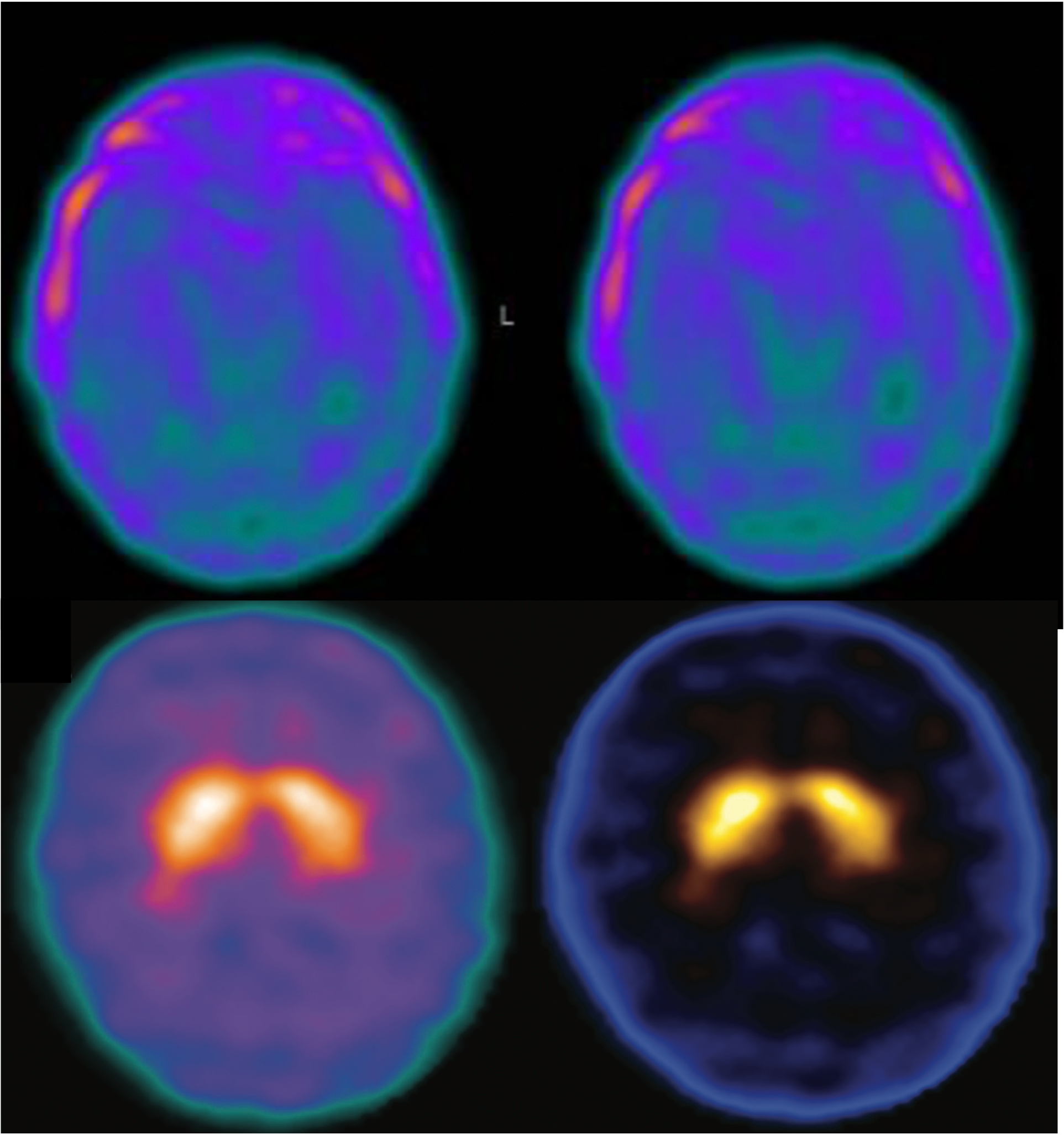Category: Ataxia
Objective: To describe a case of spinocerebellar ataxia type 3 (SCA3) presenting with tremor.
Background: Tremor is not a frequent manifestation in SCA3, especially as the initial symptom [1].
Method: A 57-year-old male developed a bilateral lower limb tremor 20 years before evaluation. After 10 years, he evolved with tremor in both arms and unsteady gait. Symptoms were progressively worsening. Family history was positive for several members with SCA3 diagnosis. Neurological examination showed resting tremor in flexion-extension of both fists, resting tremor of both legs. Action tremor was present during posture and movement of both arms, with intentional tremor worst in left arm. Hypomimia, bradykinesia of limbs, wide base and ataxic gait and nystagmus were also present. CAG expansion of the SCA3 gene displayed 67 repeats, DaT-Scan showed severe presynaptic dopaminergic denervation [figure1] and brain MRI was unremarkable [figure2]. Patient had improvement of tremor with levodopa.
Results: SCA3 is worldwide the most common autosomal dominantly inherited ataxia and represent 60% of all SCAs in Brazil. There is a wide range of manifestations that include cerebellar ataxia, pyramidal signs, supranuclear ophtalmoplegia, eyelid retraction, extrapyramidal signs, lower motor neuron disease, sensory loss, sleep disorders and weight loss [1,2]. Moro et.al proposed a classification of SCA3 in 7 subphenotypes, in which tremor and parkinsonism were present in subtypes 1, 4 and 7, that were present in 6%, 2,4% and 3% respectively [3]. We found one patient in the literature that resemble our case, presenting with young onset isolated tremor in orthostatism, before parkinsonism syndrome developed [1].
Conclusion: Although tremor is a rare symptom in SCA3, it should be remembered as part of the subphenotypes of the disease and it may respond to dopaminergic medications. Patological studies in SCA3 patients have demonstrated atrophy of the pons, basal ganglia, midbrain, medulla oblongata and degeneration of the substantia nigra is not an unusual finding. DaT-Scan in patients with SCA3 shows significant reductions of dopamine transporter density in caudate and putamen, as well as in Parkinson’s disease. It has been suggested that cerebellum influences glutamatergic and dopaminergic striatal activity and the origin of parkinsonism in primary cerebellar disorders could be related to dysfunction in cerebello-thalamo-cortical circuitry [4].
Figure 2.
Figure 1.
References: 1. Bonnet C, Apartis E, Anheim M, Legrand AP, Baizabal-Carvallo JF, Bonnet AM, Durr A, Vidailhet M. Tremor-spectrum in spinocerebellar ataxia type 3. J Neurol. 2012 Nov;259(11):2460-70. doi: 10.1007/s00415-012-6531-5. Epub 2012 May 17. PMID: 22592286.
2. Rezende TJR, de Paiva JLR, Martinez ARM, Lopes-Cendes I, Pedroso JL, Barsottini OGP, Cendes F, França MC Jr. Structural signature of SCA3: From presymptomatic to late disease stages. Ann Neurol. 2018 Sep;84(3):401-408. doi: 10.1002/ana.25297. Epub 2018 Sep 4. PMID: 30014526.
3. Moro A, Munhoz RP, Arruda WO, Raskin S, Moscovich M, Teive HAG. Spinocerebellar ataxia type 3: subphenotypes in a cohort of brazilian patients. Arq Neuropsiquiatr 2014;72(9):659-662
4. Pedroso JL, Braga-Neto P, de Souza PV, Barsottini OG. The cerebellum in Parkinson’s disease and Parkinsonism in cerebellar disorders. Brain. 2013 Sep;136(Pt 9):e248. doi: 10.1093/brain/awt089. Epub 2013 Jun 4. PMID: 23739173.
To cite this abstract in AMA style:
V. Procaci, L. de Farias, S. da Costa, O. Barsottini, J. Pedroso. Tremulous Machado-Joseph Disease [abstract]. Mov Disord. 2024; 39 (suppl 1). https://www.mdsabstracts.org/abstract/tremulous-machado-joseph-disease/. Accessed April 19, 2025.« Back to 2024 International Congress
MDS Abstracts - https://www.mdsabstracts.org/abstract/tremulous-machado-joseph-disease/


